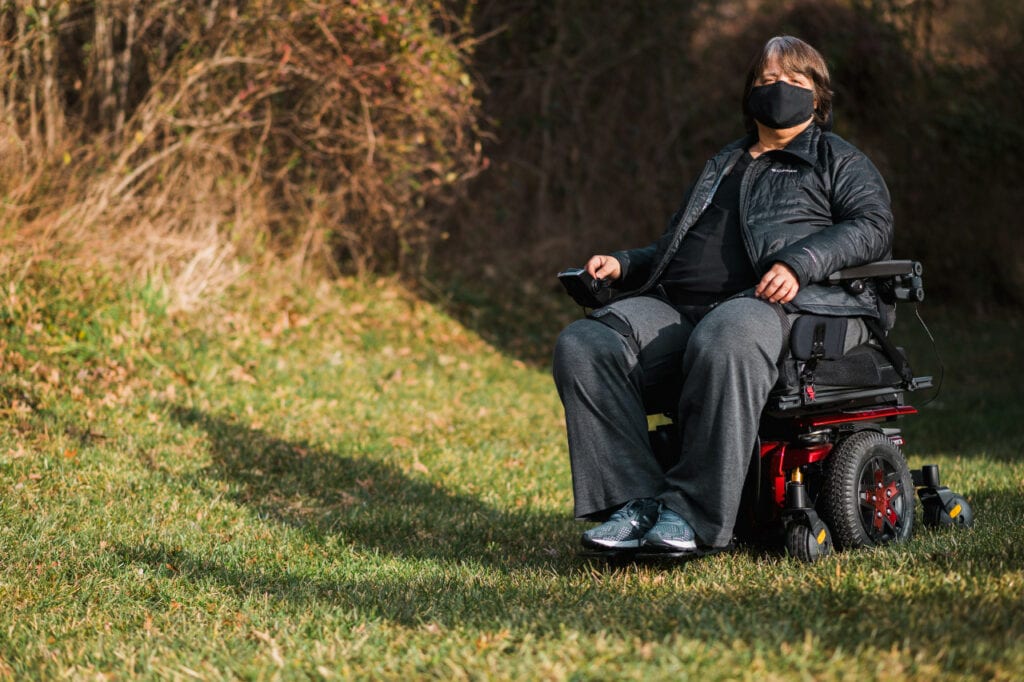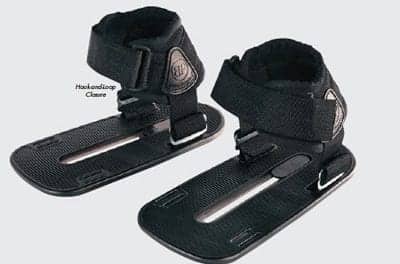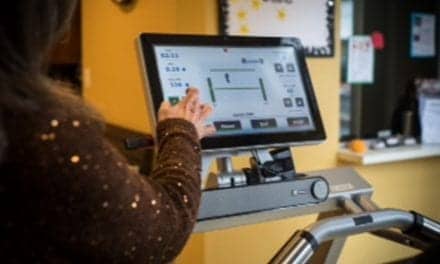PHOTO CAPTION: Power wheelchair tilt allows the user to get into proper position for shoulder strengthening exercises. With improved shoulder strength she can increase independence with transfers and decrease pain.
In traditional models, wheelchair prescription has often followed a pattern. If an individual is diagnosed with paraplegia, that person is prescribed a manual wheelchair (MWC); if the diagnosis is tetraplegia, a power wheelchair (PWC) is provided. Experience and research are now informing decisions and proving that the choice is more complicated than the above algorithm. For best outcomes it is necessary for the prescribing clinician to consider more factors and think holistically.
Historically, motivators to prescribe a MWC include the following: aesthetics, a means for exercise, and accessibility. However, it may benefit a client who would traditionally be prescribed manual mobility to consider power mobility. Seeing the whole clinical picture may challenge the traditional model of thinking and has the potential to change the outcome and life of the client.
Aesthetics
The idea that a MWC is more visually appealing and “less disabled” has seeped into the rehabilitation industry. Clients come to seating clinic desiring a MWC over a PWC because of how it looks. A person’s wheelchair is an extension of the body and, if prescribed optimally, will enhance a person’s life abundantly. Acceptance of the equipment will result in increased usage and best outcomes. Therefore, aesthetics and self-image are not to be discounted or ignored. However, it is imperative that the clinician engage in client education and consider all other factors and components in the decision, rather than allowing aesthetics to dominate.
Mobility ≠ Exercise
Individuals who need a first mobility device are frequently struck by the thought that they have recently lost their main avenues of exercise. They recognize their overall total of movement throughout the day has decreased. They then look to their mobility device prescription as a means to meet the new need of exercise, cardiovascular health or weight management.
However, mobility does not equal exercise. A person’s primary mobility device should not be a means for exercise. If propelling a MWC is challenging enough to be considered cardiovascular exercise or strengthening/conditioning, then it is too difficult to be a person’s primary means of mobility. This level of difficulty will impede motion, and the individual will therefore move less, not more. Exercise and mobility are both valid needs of all individuals. But, it is imperative that we separate these needs and seek to meet them both in different avenues.
Obesity
For the individual who is obese, PWC prescription may often be the best decision, regardless of injury level. Due to obesity, the overall force required to self-propel a MWC is much greater, causing significant strain on all the joints of the upper extremities. Furthermore, the arms are required to perform all transfers under increased strain. This quickly contributes to overuse and pain. Pain will further decrease mobility, engagement, overall function, and quality of life. Often it is in the client’s best interest to preserve the upper extremity health (especially shoulder) for all other activities of daily living by making the transition to power mobility.
Furthermore, obese clients often need MWC configurations that make the overall chair too wide to access many environments. In combining the seat width necessary to accommodate hip width with the width of the wheels and hand rims, the footprint of the MWC can exceed standard door widths and make the smaller spaces of bathrooms and hallways inaccessible. The same client can easily be comfortably seated in a PWC with the same seat width. But, because the drive mechanism is located under the seat pan, the overall footprint becomes narrower. In terms of accessibility to environment and function, this one change can be crucial.
Accessibility
While it is true that PWCs often lend to accessibility issues, it is important to consider all levels of accessibility for each client individually. A PWC is heavier, can require more home modifications, and requires specific transportation means. However, in many ways it is not more restrictive—it actually provides more function. It can afford access in terms of increased distances, participation in work and family roles, and engagement in leisure activities. Even if a client can technically propel a MWC some distances, will that person be exhausted once the destination is reached? A PWC may be the solution that gets the client to the location while preserving enough energy for that person to perform the task at hand.
PWCs have the capabilities—such as traversing variable terrain, scaling ramps/elevations, crossing thresholds—that may enlarge the client’s access to the world. Also, PWC seat functions can aid in transfers and reaching. It is crucial to investigate whether the barriers to power mobility can be overcome with education and resources prior to ruling out PWC prescription. If these environmental factors can be overcome, often an individual will have more access to their whole lives and full-spectrum function, rather than just basic access to small spaces and transportation.
Arm Strain
It is well documented that MWC users experience significant upper extremity strain. The same arms that experience this strain are required for all other activities of daily living—including transfers, self-care, work, family/community engagement, and leisure. If a client develops debilitating arm strain and pain from unnecessary overuse, this can affect every aspect of life. Considering power mobility as an option from the start of any first (or subsequent) chair prescription can preserve shoulder (and other joint) health for the rest of living. For some clients this may be the difference between health and pain/surgery, function and inability, independence and reliance, engagement and withdrawal.
Seating, Positioning, Tilt
Cushions and seat backs are a vital part of any mobility solution, and the variety of materials from which they are constructed allows them to be highly tailored to a user’s needs with consideration to support, comfort, and skin health. Wheelchair cushion and back materials include air, gel, foam, and fluid as well as modular dynamic arrays that can be shaped to any configuration. A therapist must evaluate the pros and cons of each material to arrive at a balanced solution. For example, air and foam offer a desirable lightweight quality, but air cushions may develop leaks and foam cushions may not provide maximum pressure relief. Gel cushions offer excellent pressure relief but are not lightweight and may be a more expensive option.
For some mobility users a tilt function may be the key to an optimal seating solution. For example, anterior tilt on PWCs can be used to assist with transfers and aid functional reach. Manual tilt-in-space wheelchairs are helpful in off-loading the client’s weight to help avoid pressure injuries and offer adjustable width and depth to accommodate a range of user heights and weights.
Drive Control Systems
Because power wheelchair users span a wide spectrum of functional ability, manufacturers have engineered a variety of systems that allow them to control their mobility device. Joysticks, for example, are available for users who have adequate dexterity. Users who have a higher level of impairment may need head arrays, tray arrays, or sip-and-puff systems to control their PWCs. Systems that utilize a central processing unit that combines the power of software and hardware can also be used to expand the possibilities of alternative drive control.
Long-Term Foresight
Most insurances currently require that clients utilize their prescribed equipment for 5-7 years before being eligible for a new device. They are unable to receive funding for a new piece of equipment unless they have a new qualifying diagnosis. This means an individual with a neurological diagnosis that experiences decline—whether strength, posture, endurance, or pain—is ineligible. This brings immense importance to getting the long-term decision for the client correct the first time.
Disease progression and natural aging progression need to be a top consideration in the decision of manual vs power mobility prescription. Many clients may present with function at the day and time of the evaluation that would lead the team to prescribe a MWC. However, the full spectrum of function, strength, and endurance must be considered. For example, clients with multiple sclerosis may present to a morning evaluation with the ability to efficiently propel a MWC in the clinic setting. At end of the day, fatigue may set in and render it impossible to be independent with manual mobility, leaving a person unable to function or reliant on a caregiver. A PWC may just provide the means necessary for energy conservation, allowing the client to fully engage in their life for the duration of each day. Furthermore, since multiple sclerosis is a progressive disease, the client’s needs over the long term must be considered. Can the client propel a MWC with enough skill, strength and endurance to function even when decline occurs? Furthermore, will postural needs be fully met within the constraints of manual mobility seating options?
PWCs are highly adaptable—able to change to highly supported (even custom) seating systems and power seat functions as postural needs change. Additionally, PWCs have the ability to change drive controls and drive settings to preserve function for as long as possible in the face of strength, ROM, and endurance decline. All of these adaptations are achievable from a funding perspective within the typical 5- to 7-year lifetime of a power mobility base.
The pediatric population also has significant potential with PWC mobility. Power mobility creates incredible independence and function—all while protecting developing orthopedic structures and preventing long-term upper extremity pain. Power mobility should be on the table of consideration for even the youngest and smallest of clients.
Power Can Mean Independence
Manual mobility can lead to increased reliance on caregivers. Inadequate endurance, increased pain, and inaccessibility to environments facilitate reliance on others. This is the antitheses of the goal of a primary mobility device. Mobility equals independence. Considering power mobility for the non-traditional client may afford the much-desired independence.
Maximum independence is the goal. How therapists achieve that goal is complex and multi-factorial. Aesthetics, accessibility, function, energy preservation, shoulder health, and long-term function are all factors that need to be considered in the seating evaluation. Our clients are counting on us! RM
Colleen Gillette Smith, PT, DPT, ATP, has been a physical therapist with the International Center for Spinal Cord Injury at Kennedy Krieger Institute since 2012. She completed her Doctor of Physical Therapy degree at Duke University, Durham, NC, and her bachelor of science in health sciences at Lee University, Cleveland, Tenn. For more information, contact [email protected].

Making Your Life Easier
Wheelchair accessories provide safe and stylish movement
by Frank Long, MS
Getting from Point A to Point B is no big trick. Making that same trip surrounded by accessories that enhance comfort, convenience, and safety, however, is applause-worthy and the reason that items such as bags, cupholders, canopies, and wheelchair covers has been expanding and evolving. These items provide the finishing touches to a wheelchair and cater to the user’s physical, medical, and social needs. It is a niche market that makes an outsize contribution to the overall mobility solution. Following are several examples of these popular products and how they make life easier for the mobility user.
Bags: a Must-Have
Out in the community, wheelchair users likely will need one or more personal items in close reach such as food, medication, or personal care products. Carriers available for these purposes include bags made from water-resistant nylon with multiple storage compartments that can be attached to seat backs. Likewise, for storage below the wheelchair, detachable single-pocket bags or “cargo shelves” can be attached to frame fronts for secure storage kept out of sight. “Saddle bags” are another option that can be strapped around an armrest for easy attachment and quick access.
Canopies: Portable Protection
Rain, sleet, and snow are a fact of life, but regardless of inclement weather, wheelchair users must engage in their communities. To keep them mobile during bad weather (or under a scorching sun), a mountable canopy can shield a wheelchair user—as well as the wheelchair itself—from damaging moisture and heat. Canopies made of weather-resistant nylon are available in adult or pediatric sizes and offer three-sided protection with reflective qualities to promote visibility. The latest canopies are built to be easy to remove as well as easy to store and carry on the wheelchair.
Hold Everything!
Cell phones are essential in the 21st century, and few wheelchair users would want to leave home without one. Manufacturers have responded to this reality by introducing cell phone holders designed especially for wheelchair use. These important accessories are made from reflective polyester material and can be attached to horizontal tubing for use with walkers and crutches. Today’s mobility devices must also accommodate a user’s taste for “personal luxuries” such as gourmet coffees, energy drinks, and bottled water. To make these creature comforts easier to enjoy, a variety of cupholders is available ranging from those that hold beverages with a 1-inch circumference to models that accommodate a 32-ounce sports drink. They are made to be unbreakable and attach to armrests for front and horizontal grip.
Accessories don’t make a trip shorter but they make it better. RM
Related Content:
Solving Complex Rehab with Expertise and Innovation
Transforming the State of Complex Rehab Technology from Within





